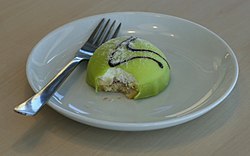Top Qs
Timeline
Chat
Perspective
Princess cake
Traditional Swedish layer cake From Wikipedia, the free encyclopedia
Remove ads
Princess cake or princess torte[1][2] (Swedish: prinsesstårta) is a traditional Swedish layer cake or torte consisting of alternating layers of airy sponge cake, pastry cream, and a thick-domed layer of whipped cream. The cake is covered by a layer of rolled marzipan, giving it a smooth, rounded top. The marzipan overlay is usually green, sprinkled with powdered sugar, and often decorated with a pink marzipan rose.[3][4] While the original recipe did not contain any fruit, modern versions usually include layers of jam[4] or fresh fruit, usually raspberries.
Remove ads
Origin and name

The original recipe first appeared in the 1948 Prinsessornas kokbok cookbook, which was published by Jenny Åkerström (1867–1957), teacher of the three daughters of Prince Carl, Duke of Västergötland.[5]
The cake was originally called grön tårta (green cake), but was given the name prinsesstårta or "princess cake" because the Swedish princesses were said to have been especially fond of the cake. The princesses were Princess Margaretha (1899–1977; later Princess of Denmark), Princess Märtha (1901–1954; later Crown Princess of Norway), and Princess Astrid (1905–1935; later Queen of the Belgians).[6][7][8]
Remove ads
Variants
Prinsesstårta has historically been called, or appeared in variants known as, green cake, regent cake, and opera cake.[9] Variants with other colours of marzipan are occasionally called prinstårta (prince cake) and sometimes Carl Gustaf cake when covered with yellow marzipan. Operatårta (opera cake) is a variant with red or pink marzipan.
A frog cake is a broadly similar Australian dessert that (aside from a bit of buttercream) is a smaller kind of prinsesstårta, decorated to resemble a frog’s face, with a cut in the marzipan forms the mouth.[4]
Variants with jam in the bottom layer are often called opera cake.[10]
- Variants
- Individual serving size
- Pink and gold
- Green with marzipan rose
- Decorated with a Christmas theme
Remove ads
Theme week
Since 2004, there's been a "princess cake week" in Sweden held each September, with proceeds going to a royal charity.[11] Since 2004, the organization Sveriges bagare & konditorer (Sweden's Bakers & Confectioners) has promoted the last week of September as "Princess Cake Week".[12]
The first Thursday in March has become a well-known concept, primarily in Småland, where princess cake is eaten on this day. This is because the first Thursday in March is Småland's unofficial national day, and to honor the Småland dialect, it is called "fössta tossdan i mass" ('First Thursday in March').[13]
Storage
Princess cake contains cream and can be stored in the refrigerator for several days, or frozen. The powdered sugar melts when it becomes moist. To prevent this, moisture-resistant powdered sugar can be used, or it can be dusted on just before delivery or serving.[14]
See also
References
Wikiwand - on
Seamless Wikipedia browsing. On steroids.
Remove ads





